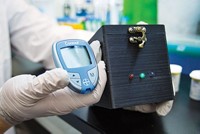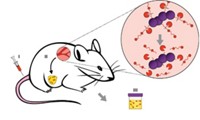Advertisement
Grab your lab coat. Let's get started
Welcome!
Welcome!
Create an account below to get 6 C&EN articles per month, receive newsletters and more - all free.
It seems this is your first time logging in online. Please enter the following information to continue.
As an ACS member you automatically get access to this site. All we need is few more details to create your reading experience.
Not you? Sign in with a different account.
Not you? Sign in with a different account.
ERROR 1
ERROR 1
ERROR 2
ERROR 2
ERROR 2
ERROR 2
ERROR 2
Password and Confirm password must match.
If you have an ACS member number, please enter it here so we can link this account to your membership. (optional)
ERROR 2
ACS values your privacy. By submitting your information, you are gaining access to C&EN and subscribing to our weekly newsletter. We use the information you provide to make your reading experience better, and we will never sell your data to third party members.
Analytical Chemistry
A Simple Test Spots Bacteria
Biosensors: A strip of filter paper changes color when exposed to bacteria
by Erika Gebel
June 9, 2011

In the developing world, drinking water contaminated with bacteria kills millions of people each year. Most methods to test drinking water for pathogens require expensive lab equipment and expert training, two resources many communities lack. To offer a cheap, simple alternative, researchers now demonstrate a test strip that changes color in the presence of bacteria (J. Am. Chem. Soc., DOI: 10.1021/ja2021729).
“There’s basically no easy way to tell if water has bacteria in it,” says Vincent Rotello of the University of Massachusetts, Amherst. To build a simple test, he and his colleagues embedded a biosensor in a strip of filter paper. When exposed to bacteria, the biosensor changes from yellow to red within 10 minutes.
On the filter paper, the researchers spotted a mixture of gold nanoparticles, the enzyme β-galactosidase, and a yellow dye, chlorophenol-red-β-D-galactopyranoside. Before mixing, Rotello’s team made the surface of the nanoparticles positively charged so they would attract the negatively charged enzyme. When stuck to the particles, the enzyme is inactive and can’t react with the dye.
But bacteria can free the proteins from the nanoparticles’ grasp. The microbes are negatively charged and bind the nanoparticles more strongly than the enzyme does. Once free, the enzymes convert the yellow dye into a red dye.
Because a single enzyme molecule can turn over many dye molecules, Rotello says the sensor doesn’t require large amounts of the nanoparticles or enzyme. As a result, the strip’s costs should be low. He also points out that the biosensor isn’t fooled by small molecules, which can’t pry the enzymes from the particles. “The system is only responsive to big stuff,” he says.
The researchers could observe color changes going from clean water to solutions containing as few as 10,000 bacteria per milliliter of water. Rotello hopes to improve the sensitivity to between 10 and 100 bacteria/mL. The most virulent microbes still can cause disease even at those low concentrations.
The strips worked beautifully in the laboratory, says Chad Mirkin of Northwestern University, but he worries about their effectiveness in the field. The interactions between the nanoparticle, enzyme, and bacteria are not very specific, he says. Still, he thinks that if the researchers can demonstrate the sensor’s selectivity in the real world, the system would be a “spectacular approach.”





Join the conversation
Contact the reporter
Submit a Letter to the Editor for publication
Engage with us on Twitter